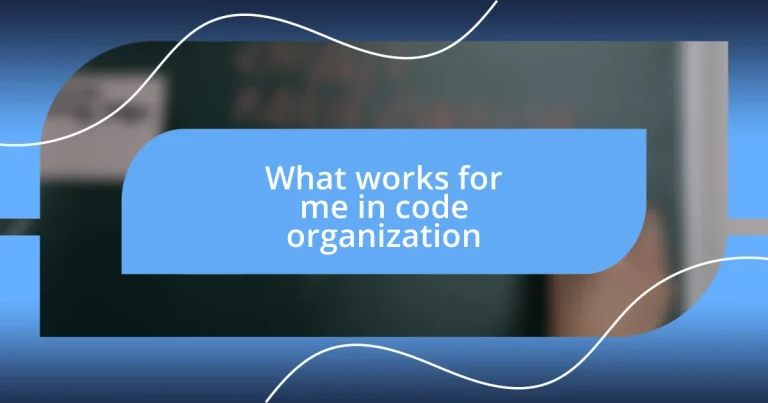Key takeaways:
- Organized code reduces debugging time, enhances team collaboration, and allows for smoother project evolution.
- Key principles of effective code organization include the DRY principle, modularity, and consistent naming conventions.
- Common mistakes to avoid are lack of documentation, ignoring code reviews, and neglecting edge cases, while tools like IDEs, dependency managers, and linters aid in maintaining organization.
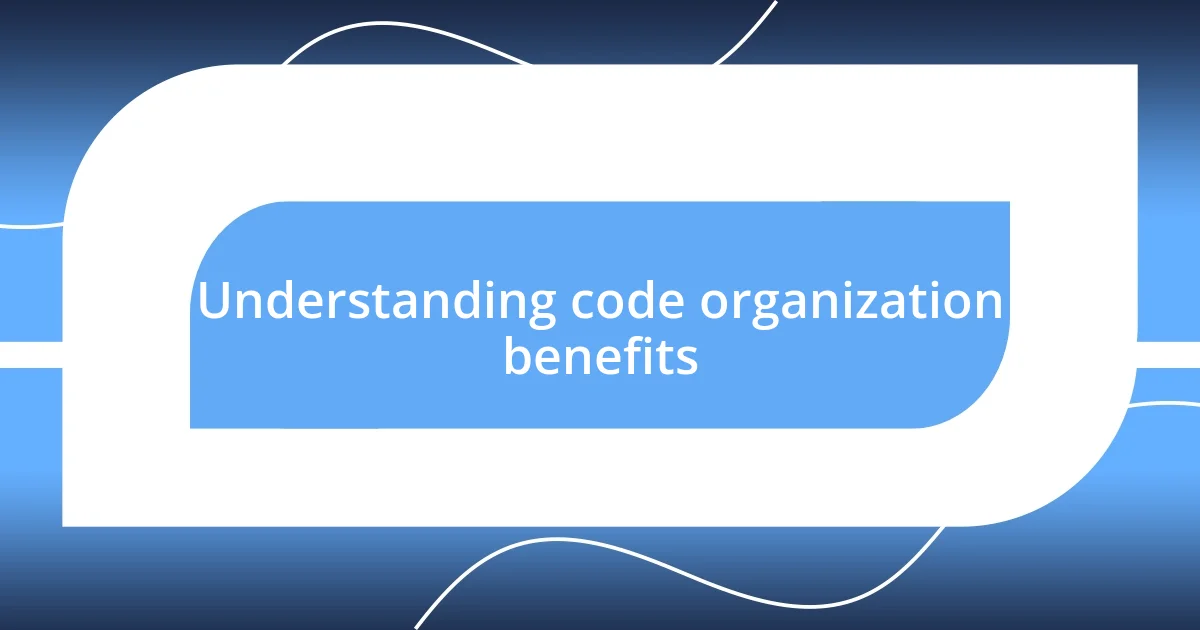
Understanding code organization benefits
One of the standout benefits of organized code is the significant reduction in debugging time. I remember a project where I had to sift through a spaghetti mess of functions. It was frustrating and time-consuming. Once I implemented a cleaner structure, the ease of locating errors was like turning on a light in a dark room!
Additionally, organized code often leads to improved collaboration within teams. Have you ever struggled to understand a colleague’s code? I certainly have! With clearly labeled sections and consistent naming conventions, I found it so much easier to grasp others’ thoughts. This not only enhanced our productivity but also fostered a greater sense of teamwork and communication.
Moreover, well-organized code can evolve more gracefully as projects grow. I think back to an app I worked on that started small but quickly expanded. By maintaining a clear hierarchy and keeping related files together, I was able to adapt to new feature requests without feeling overwhelmed. It’s almost like having a well-ordered toolbox—when you know where everything is, building becomes a breeze!
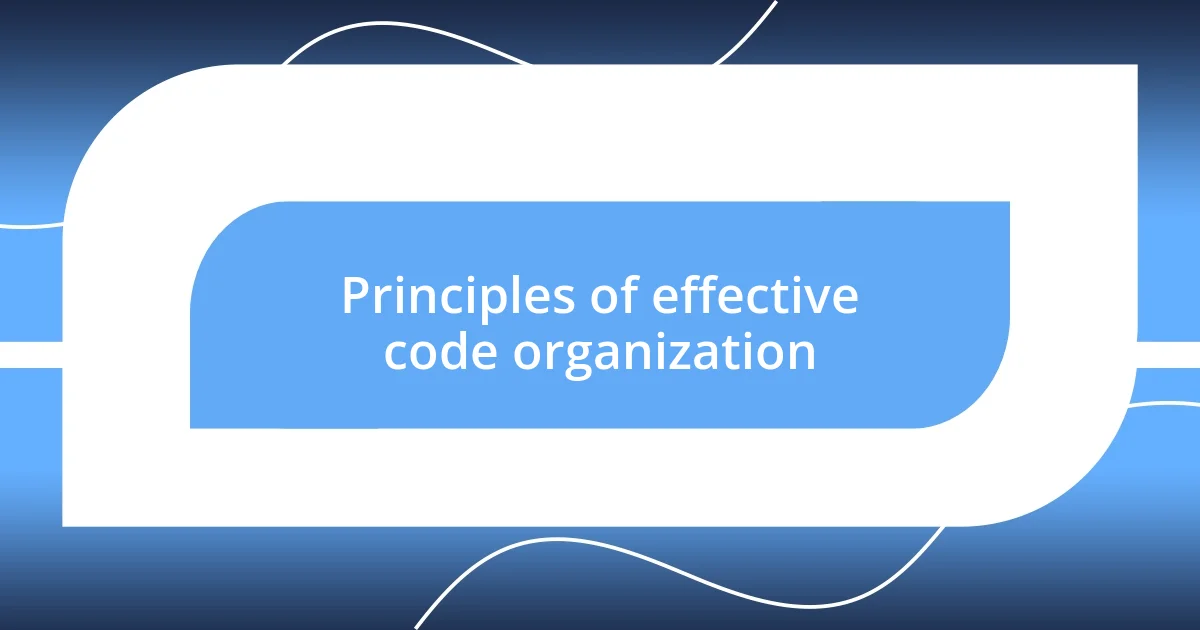
Principles of effective code organization
Effective code organization is guided by a few core principles that can make a world of difference in a developer’s experience. One principle I cherish is the DRY principle, which stands for “Don’t Repeat Yourself.” I recall a time when I neglected this principle, leading to duplicated logic scattered across my codebase. It became a maintenance nightmare! Once I embraced DRY, I noticed not only improved efficiency but also the satisfaction of working with a leaner, more manageable codebase.
Another key aspect of code organization is modularity. Breaking code into smaller, self-contained modules allows for better testing and reuse. I vividly remember refactoring a monolithic piece of code into manageable modules. The exhilaration I felt when I could test each module independently and ensure they worked seamlessly together was incredible! It brought to light the real power of modular development—making updates easier and reducing the risk of introducing bugs.
Lastly, consistent naming conventions cannot be underestimated. They serve as a common language across your code, bridging the gap between what something is and what it does. I’ve often seen developers struggle to decipher variable names that are cryptic or inconsistent. By establishing and sticking to a naming standard, I’ve transformed confusion into clarity. This shift not only enhances readability but also instills confidence in the code’s functionality.
| Principle | Description |
|---|---|
| DRY (Don’t Repeat Yourself) | Avoid code duplication for easier maintenance. |
| Modularity | Break code into smaller, self-contained pieces for ease of testing and reuse. |
| Naming Conventions | Use consistent naming to improve code readability and understanding. |
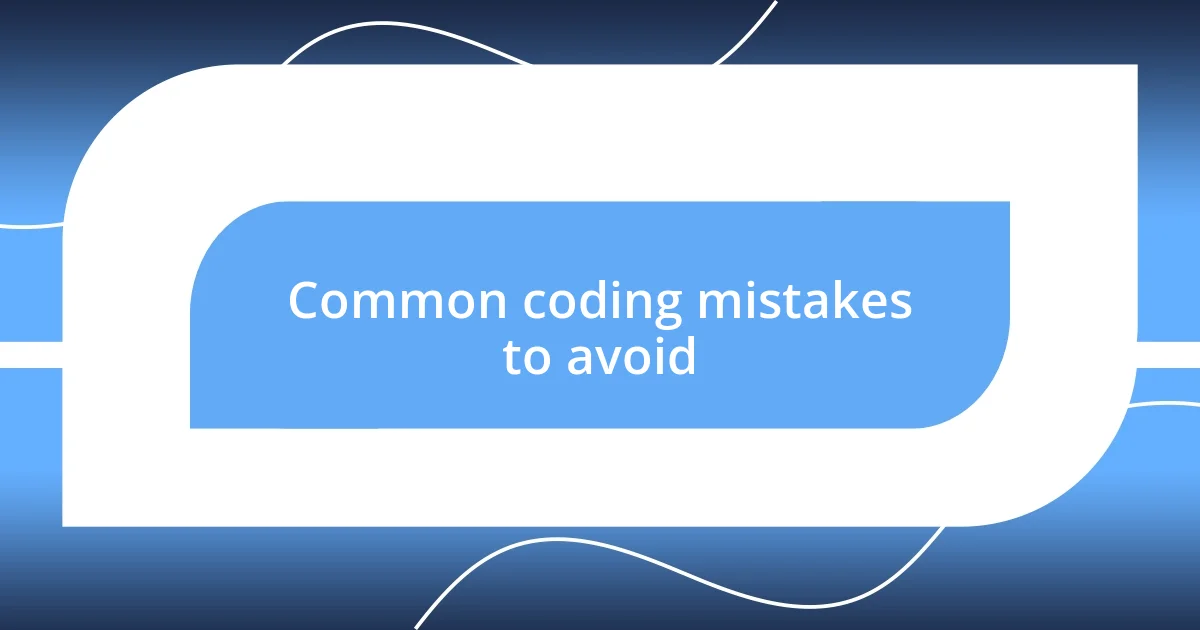
Common coding mistakes to avoid
I’ve seen firsthand how certain coding habits can lead to chaos, making it harder to manage projects effectively. One common mistake is neglecting documentation. I once rushed through development, thinking I could keep everything in my head. However, when I returned to the code weeks later, it felt like deciphering an alien language. I learned that taking a few moments to explain my thought process made all the difference in understanding my own work. Another mistake is ignoring version control. Missing those important commits can lead to headaches in collaboration. I’ve learned to embrace tools like Git, which not only track changes but also offer safety nets during development.
Here are a few common coding mistakes to avoid:
- Lack of Documentation: Failing to document code can lead to confusion and increased time spent trying to remember why a certain approach was taken.
- Ignoring Code Reviews: Skipping peer reviews often means missing out on valuable feedback that can catch mistakes early.
- Hardcoding Values: Instead of hardcoding, I’ve learned to use configuration files, which makes future changes less tedious and more flexible.
- Neglecting Edge Cases: I’ve been caught in the trap of testing only the ideal scenarios. Incorporating edge cases is crucial for robust code.
- Overcomplicating Logic: Sometimes, I try to create overly complex solutions. I’ve come to appreciate that simplicity often leads to more maintainable and readable code.
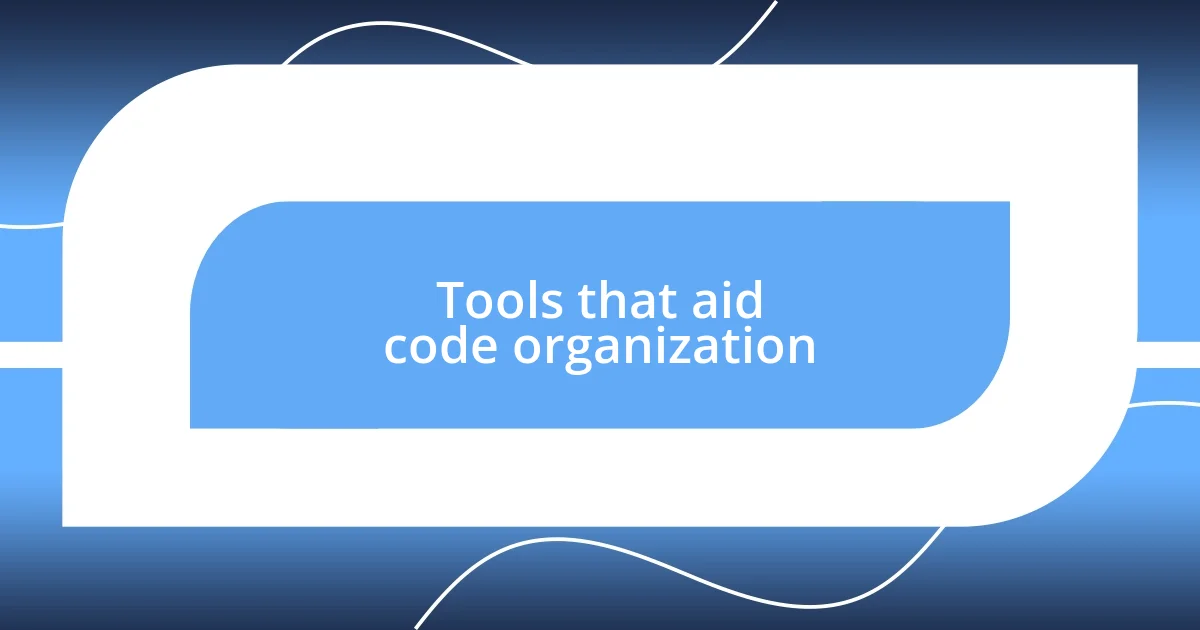
Tools that aid code organization
Using the right tools for code organization can be a game-changer. For instance, I rely heavily on Integrated Development Environments (IDEs) like Visual Studio Code or JetBrains. These platforms make navigating through files a breeze, allowing me to jump between functions or classes instantly. I remember the first time I used a code folding feature; it was like discovering a new layer of control over my projects. Suddenly, I could focus on what mattered without getting lost in the weeds.
Another fantastic tool that revolutionized my approach to code organization is a dependency manager. When I first started using npm for my JavaScript projects, it opened my eyes to the power of handling libraries and dependencies seamlessly. I would often forget which versions of packages I was using in my projects, leading to frustrating compatibility issues. But with npm, I can easily track versions and ensure my environment remains stable. Have you ever had that sinking feeling when a project breaks because of an outdated library? Now, I feel much more confident managing my dependencies.
Finally, have you ever tried using a linter? I find tools like ESLint to be indispensable in maintaining code quality and style. The first time a linter flagged a mistake in my code, I felt a mix of embarrassment and gratitude. It’s like having an extra pair of eyes that help me adhere to best practices. By catching issues early, I save countless hours in debugging down the line. It’s these small victories that make coding more enjoyable and my projects more successful.
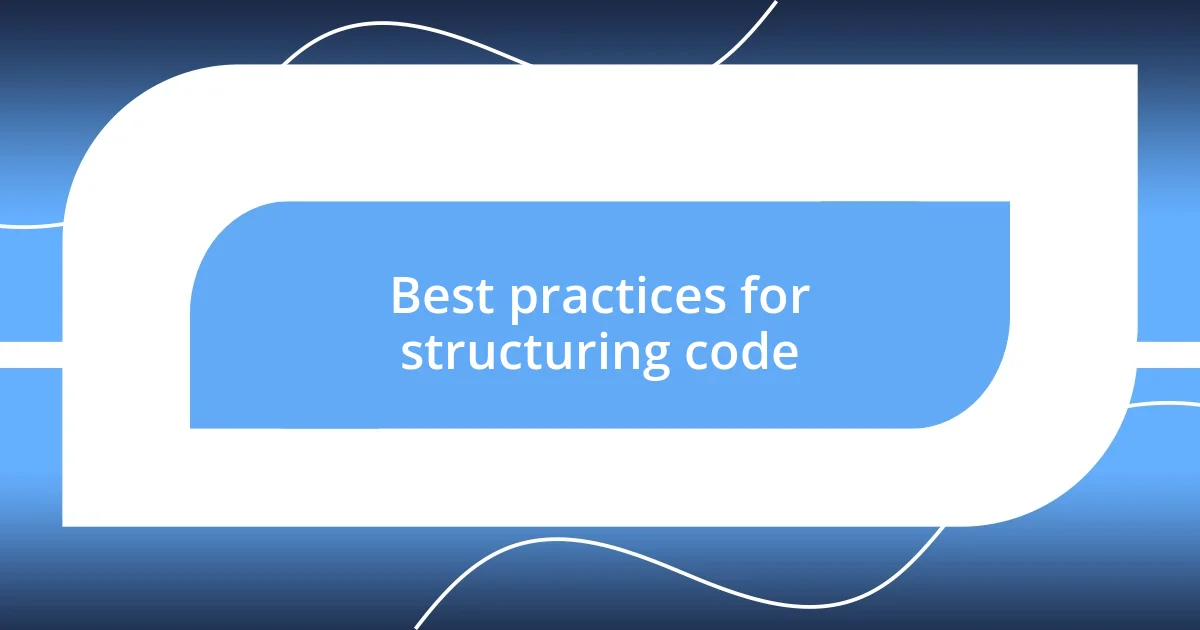
Best practices for structuring code
Structuring code effectively is something I’ve grown to prioritize immensely. One best practice I swear by is keeping functions small and focused. I remember early on, trying to cram too much functionality into a single function because I thought it would be efficient. The opposite was true; I ended up with spaghetti code that was impossible to debug. Now, whenever I write a function, I ask myself if it can be simplified. If it can, I split it up! This not only makes testing easier but also improves readability, helping others (and my future self) understand what the code is doing.
Another practice that has transformed my coding approach is consistent naming conventions. I used to arrive at quirky names for variables and functions, thinking I was being clever. But honestly, I would often forget what they referred to after a couple of days. Adopting a clear and standardized naming convention, like using camelCase for variables and descriptive names for functions, made a world of difference. When I read through my code now, I can instantly grasp what each piece is doing. Doesn’t that sound refreshing?
Lastly, I’ve found that organizing files logically is paramount. In my experience, grouping related files into folders based on functionality rather than file type has helped tremendously. When I look at a project structure where APIs, services, and components are all in one place, it feels like everything is connected, almost like a well-organized library. Trust me, at the end of the day, having a tidy project structure eases the mental load when diving back into the code—it’s like walking into a clean room versus a messy one!
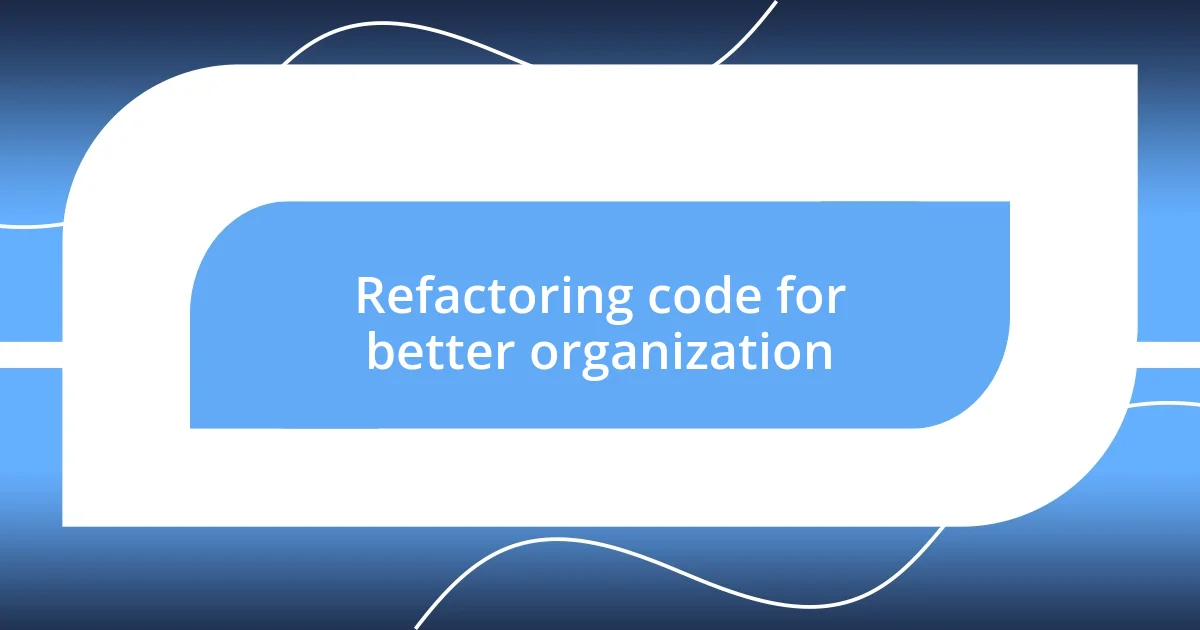
Refactoring code for better organization
Refactoring code is something I believe can transform not just the organization of your projects, but also your mindset as a developer. I’ve been in situations where I inherited a codebase that felt like a maze—everything was convoluted, and I often asked myself, “Where do I even start?” That’s when I learned the importance of systematically refactoring my code. By breaking down complex structures into manageable pieces, I could see the clarity emerge, and the satisfaction I felt after smoothing out the rough edges was like polishing a gem.
One technique that has yielded remarkable results for me is the practice of eliminating redundant code. I vividly remember a project where I had written nearly identical functions for different functionalities, thinking it was efficient. However, it was a headache to maintain. Once I took a step back, generalized those functions, and implemented them across the board, the relief was palpable. Not only did it make the code cleaner, but I also felt empowered to add new features without the fear of destabilizing the existing code. Doesn’t it feel great to create something that grows organically rather than patching it together?
Moreover, I’ve found that enlisting peer reviews can be a game-changer during the refactoring process. I recall a time when a colleague pointed out an overly complicated section of my code, and at first, I felt defensive. But after taking a breath and considering their perspective, I realized how much clearer my logic could be. Having an extra set of eyes not only helps catch pitfalls but also inspires fresh ideas for organization. It becomes a collaborative journey that improves not just your code, but you as a developer. Have you ever had a similar experience where feedback opened your eyes to new possibilities? Trust me, embracing this practice can lead to a more robust and better-organized codebase.
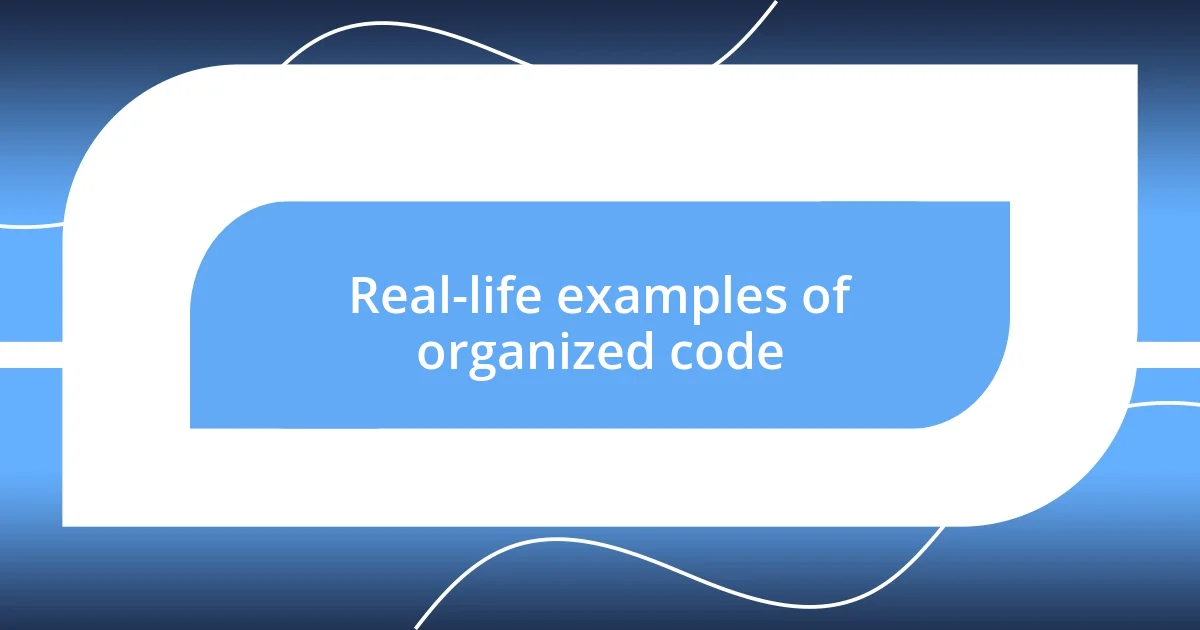
Real-life examples of organized code
One real-life example that stands out for me was a web application I worked on where we split our components into smart and dumb components. Initially, everything was jumbled together, which muddied the data flow and left me scratching my head while debugging. Once I reorganized the code, placing stateful components in one section and stateless in another, the clarity became almost euphoric. I could actually see the pathways data took, and it felt like I had illuminated a once-dark room. Have you ever felt that rush when everything just clicks into place?
In another project, I experimented with using well-defined modules to structure my code. I remember one late night of coding confusion when I realized the file just kept growing and growing, becoming an unwieldy monster. By breaking it into small, cohesive modules, each responsible for a specific task, my productivity skyrocketed. Suddenly, I could understand the purpose of each module at a glance. It felt like untangling a knot; with each module I separated, I could breathe freer. Does it resonate with you when I say that a well-structured project saves countless hours in the long run?
Lastly, I like to implement detailed comments and documentation as part of my coding practice. I recall a project where I didn’t do this extensively, thinking I’d remember what everything did. Fast forward a few months, and I was lost in my own code! Now, I make it a point to write meaningful comments that not only explain “what” a piece of code does, but also “why” it does it. This practice helps both me and my teammates reconnect with the code’s intention, sparking joy in simplifying the learning curve for anyone new to the project. Isn’t it invigorating to craft code that speaks clearly, even to someone who hasn’t touched it before?












